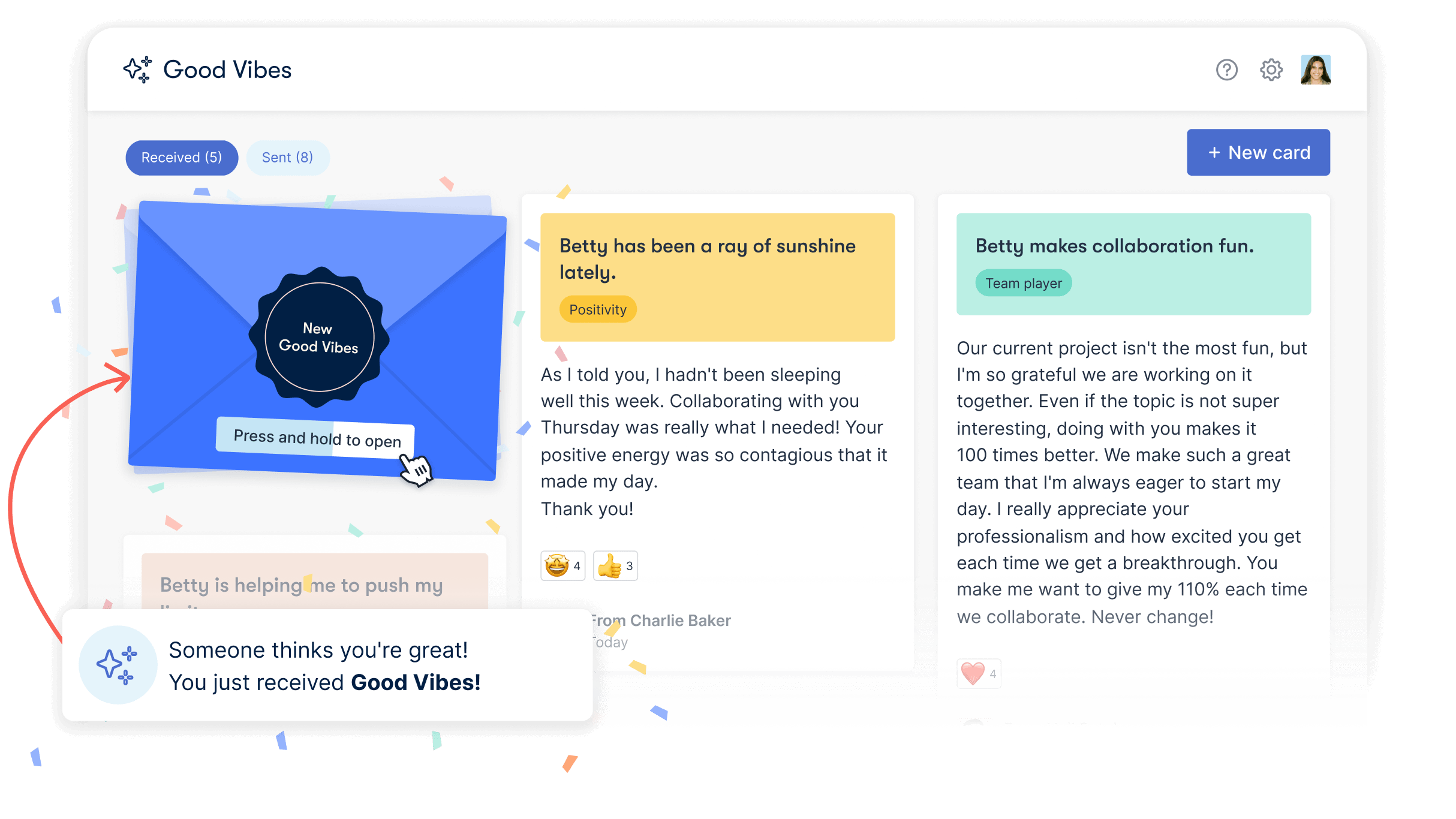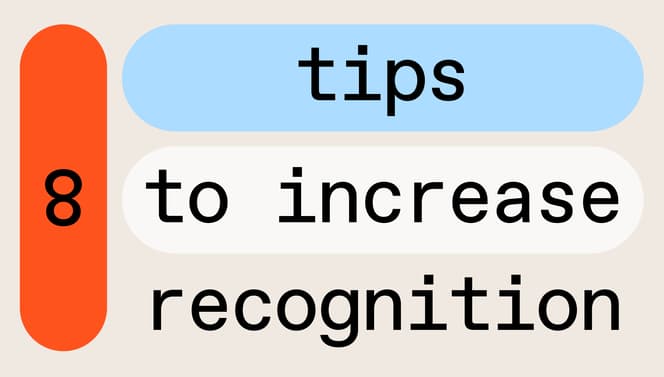We all like to know that someone sees and appreciates our efforts. When you recognize and reward employees' hard work, you improve employee motivation, boost their loyalty to the organization, and create a more positive company culture.
So how can you improve employee recognition, especially in a dynamic workplace where many people work remotely? Read on to discover the most effective ways managers and leaders can improve recognition and boost employee morale.
Assess your organization’s employee experience in minutes

What's in this article
The importance of employee recognition in the workplace
In today's intensely competitive and stressful workplace climate, people don't just work for a paycheck. Employees also need to feel recognized and valued to sustain their mojo.
Research shows that individual and public recognition can boost employee motivation, improve performance, and reduce attrition. A full 91% of employees say recognition is meaningful, even if it's just a simple "Thank you!"
Today, many organizations understand that showing appreciation for employees can:
- Make employees happier and more ready to learn new skills that will make them an even better fit for their role
- Increase employee engagement and promote team collaboration
- Improve staff retention and help keep valuable talent within the organization
- Foster friendly competition between team members
- Boost employee morale during challenges, like working towards a tight deadline
8 ways to improve recognition in the workplace
Here's some good news: you don't need to spend a lot of money (or any!) to recognize your employees or make them feel appreciated.
In fact, it’s been shown that cash rewards can actually decrease intrinsic motivation. Companies without a large budget for employee rewards can develop an effective and authentic recognition program without spending money with the following low-cost high-impact suggestions.
#1: Make employee recognition genuine and impactful
Giving kudos should be intentional and well thought out. Sending a robotic “thanks” or “great job” every time an employee goes the extra mile won’t get you much further than not recognizing them at all.
That said, recognition doesn’t have to be long and tedious to give. Including these simple points in your message will make sure it’s authentic and effective, ultimately helping you boost your employee engagement:
- Include a short but clear recap of what they accomplished
- Mention the value it brings to the team and/or organization
- Share any shoutouts you received from other employees and leaders
- Add a personal flare and warmth
For example, rather than just saying, “Great job on building this landing page,” say something like, “I really appreciate your efforts in fixing the glitches on the homepage. Your work helped us reach our campaign targets, and our customer acquisition team is so excited about the improved user experience!” The key here is sincerity; if you don’t mean it, don’t say it.
#2: Advocate for regular virtual recognition
With a distributed workforce, employees, especially those that are fully remote, may sometimes feel disconnected at work. It’s normal. Casual chats by the coffee machine aren’t as common or may not even happen at all for some team members.
Making real-time virtual recognition a habit and even the norm can make sure everyone feels seen and appreciated, no matter where they choose to work from. From video sessions, to Slack channels, to a recognition platform, the opportunities for remote employee recognition are endless.
Pro tip: host casual virtual games and get-to-know-me sessions that add a more fun and personal touch to professional relationships.

#3: Prioritize employee engagement
Employee appreciation and recognition go hand in hand with employee engagement, which is critical to the success of any organization. Rewards and recognition motivate employees to invest more in their performance and go the extra mile to advance and fulfil company-wide goals.
A strategic employee recognition program will also include elements that improve engagement, like building connections, encouraging collaborative teamwork, and providing real-time feedback and praise. Engaged employees are happier, more productive, and less likely to seek out professional opportunities elsewhere.
Officevibe's employee engagement platform can help you assess engagement levels in your company and map out a plan to boost employee motivation.
#4: Provide career development opportunities
Investing in an employee’s professional development is one of the most effective ways to incorporate recognition into your company culture. Nurturing your employee’s career development is like saying, "We believe in your abilities and want to keep you in the company long-term."
Today, many employees prioritize professional growth and are more likely to stay in a company that understands and promotes their long-term career goals. While some larger corporations subsidize their employees' MBAs or provide other scholarships, an organization can also help its employees develop their careers with:
- Targeted mentorship programs and workshops
- Flexible work options for employees balancing work and academics
- Setting goals using OKRs
Employees can upskill with both hard skills (i.e. learning a programming language), and soft skills like leadership, empathy, and communication.
A good manager will encourage employees to reflect on their strengths and plan their career for the next year, five years, and 10 years.
#5: Promote peer-to-peer recognition
Recognition and appreciation shouldn't just flow from managers to employees. A healthy company culture encourages employees to value, acknowledge, and motivate their peers. When team members share peer recognition and support, the entire crew works better together.
Promoting recognition between colleagues can lead to:
- Improved collaboration. When coworkers uplift rather than compete, it encourages mutual trust and cooperation. While a bit of inner competition is healthy, managers should emphasize that individual success is team success.
- Higher job satisfaction. Employees who are supported and acknowledged by their peers are happier with their workplace and less likely to look for a new job.
- Increased motivation. Positive feedback and recognition from colleagues can boost employee initiative and autonomy.
Managers can encourage inter-team recognition using different methods like sending appreciation messages on Slack channels or implementing an anonymous shout-out platform.
#6: Acknowledge work anniversaries and other milestones
In a large company, employees may wonder how much they really matter. Acknowledging each employee’s work anniversary shows them that the company values them.
The “workiversary” recognition message can appear on a physical board or a communication app and say something like, "Two years ago today, Susan joined our team. We all treasure Susan’s commitment, initiative, and willingness to lend a helping hand.”
You could also turn the spotlight on successful past projects that played a major role in your business with a message such as: “Exactly one year ago today, we signed the contract with our biggest client. We could never have done this without David’s skilled networking.”
#7: Recognize employees' personal accomplishments
Recognition in the office is not just about highlighting a great PowerPoint presentation or a thorough annual report. In a positive company culture, a tight-knit team celebrates its people’s personal milestones, like getting married, having a baby, or completing an academic degree.
Employee recognition programs may also acknowledge employees whose personal endeavors reflect company values, like giving back to the community through volunteering or fundraising.
#8: Carve out time for recognition during team events
We love recognizing employees regularly and virtually. With the right tools, it’s easy, tidy, and accessible. But sometimes nothing compares to being celebrated or celebrating someone else in person. It's the cherry on top of the recognition sundae.
Whether your team has gatherings once a month, quarter, or year, taking the time to recognize them during these events will bring an extra layer of motivation and engagement. The important thing is to let employees know that you value them not only for their productivity, but for who they are as individuals.
Pro tip: For smaller team gatherings, make a list of the milestones and/or accomplishments (promotions, work anniversaries, birthdays, etc.) that happened since your last event and take 5 minutes to give each person a shoutout or toast.
Tips for successful employee recognition programs
We’ve walked you through why you should work toward improving recognition in the workplace and the ways to go about it, but now we’ll go through some handy and actionable tips for making your people feel seen at work.
Give real-time recognition
When you want to highlight someone’s accomplishments, there’s no better time than the present. Thank your employees for their outstanding work in real time, even if you plan to offer a more structured reward later.
Emails are great tools for real-time recognition. Acknowledge your employees' successes, big or small, using our email templates for expressing gratitude.
Recognize efforts, not just success
We all love to have our work yield positive results: a major contract, new clients, or an inflow of sales. However, your employees deserve to feel appreciated for their extra hours and effort regardless of the outcome.
Ask for feedback
Is your recognition program working? Does it improve your employee engagement rates and promote a healthier, more supportive company culture?
An employee survey can help you assess how much your employees benefit from the program and what changes you can implement to show employee recognition even more effectively.
Demonstrate team appreciation with Officevibe
Create a healthy recognition culture in your organization with Good Vibes, Officevibe's newest platform for highlighting effort and the little victories in everyday tasks. Motivate your employees with personal recognition tools that help improve team vibes and create a more positive workplace.
Equip HR and managers with tools to engage, recognize, and drive performance.




